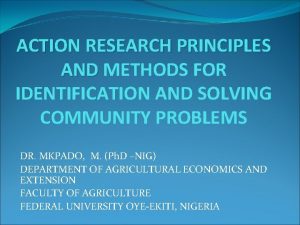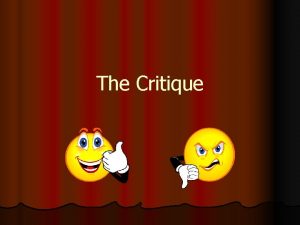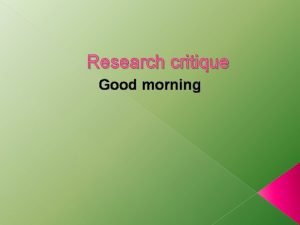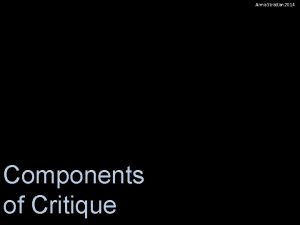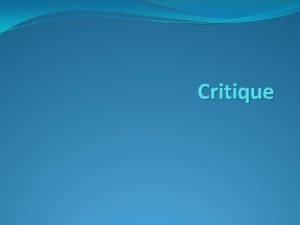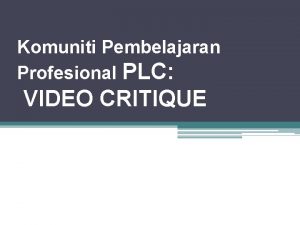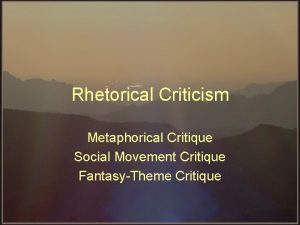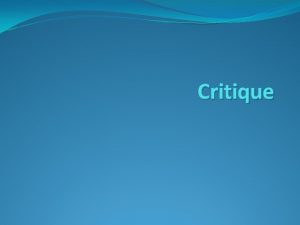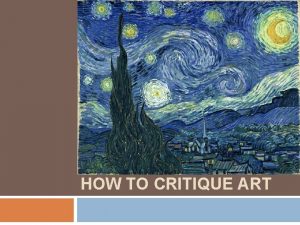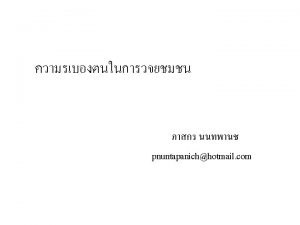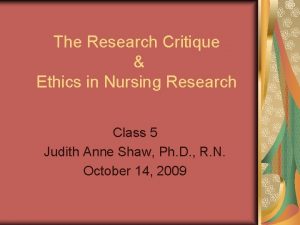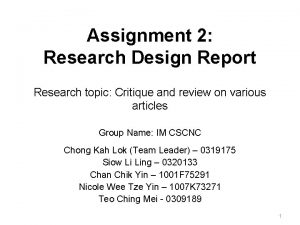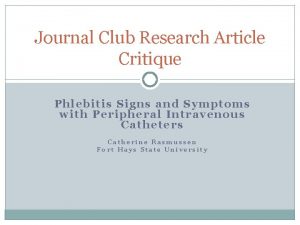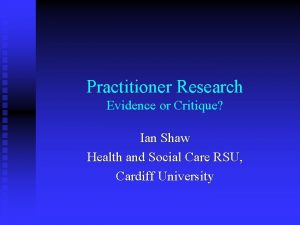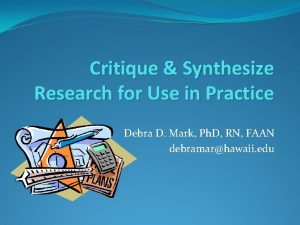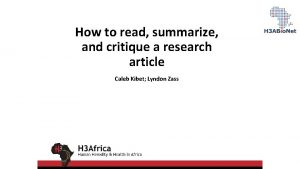Chapter 20 The Research Critique Research Critique A
































- Slides: 32

Chapter 20 The Research Critique

Research Critique • A critical appraisal of a piece of completed research • Identifies both the strengths & limitations • Usually 3 -4 pages long

4 Stages of the Critique Process • Understanding the purpose & problem & determining if the design & methodology are consistent with the study purpose • Is the methodology applied properly • Are the outcomes & conclusions believable & supported by the findings • Overall quality, strengths & limitations, contributions to knowledge & suggestions for improvement in the study

Critiquing Quantitative Studies • See p. 613 (Box 20. 1) for the Stages & Components for critiquing a quantitative research report

Criteria for Quantitative Critique 1. Clear statement of purpose 2. Clear link between purpose and problem statement/question/hypothesis 3. Literature review 4. Theoretical framework 5. Congruence of purpose, design, and method

Criteria Cont. 6. Appropriate sampling procedures (size & type) 7. Statistical procedures appropriate 8. Adequate reliability & validity checks to accept findings and generalize to appropriate populations 9. Significance of study for nursing is discussed

Key Questions: Purpose/Problem Statement • • • Is the study problem and purpose statement clearly articulated? Are reasons for conducting the study stated? Is the study’s potential contribution to nursing knowledge stated? Are the research objectives or research questions or hypotheses stated clearly and researchable (answerable through the collection of empirical data)? Are terms defined conceptually and operationally?

Literature Review • • • Does the literature review or theoretical framework provide evidence that the researcher has synthesized the classic and current literature and placed the research question in the proper context? Does the literature review identify gaps in knowledge, suggest how the current study extends the knowledge base in this area, and points out contradictions in the current knowledge base? Does the researcher summarize the literature review, provide rationale for the current study and show this study will extend previous research?

Design • • Is the study design specified, including its advantages and limitations for the research problem? Is there evidence that a pilot study had been conducted and the findings were used to enhance the design? Is the design (overall plan of research) appropriate to the research purpose and capable of answering the research question? How does the design control for extraneous variables?

Sample • Was probability or non-probability sampling used and the reason for choice specified? • Is the population to whom results will be generalized described? • Are precautions taken to avoid collecting a biased sample (see Chapter 9) that would limit generalizability of findings? • Are the demographic characteristics of the sample described? • Is the sample representative of the population? • Are inclusion and exclusion criteria identified? • Is the sample size appropriate to meet assumptions of statistical tests?

Data Collection • • Are data collection methods appropriate to meet the study purpose and answer the questions/hypotheses? What evidence is provided that data collection procedures are valid and reliable? Are adaptations to data collection tools described? Are data collection instruments described in sufficient detail to enable the reader to ascertain method of scoring, range of values, and what a particular score means?

Data Analysis • • Are data analysis procedures described? Are the statistical techniques appropriate for the study methodology (that is, the type of data collected analysis)? Do the statistical tests answer the research questions and specify level of significance? If results are nonsignificant, is a power analysis conducted to explore nonsignificant findings (see Chapter 15)?

Human Rights • How are rights of research participants protected? • Are ethical issues anticipated and handled appropriately?

Procedures • • • Are techniques used to ensure that there is consistency in the data collection process? What procedures were used to keep research conditions the same for all participants? Are there strategies to limit errors in data collection, recording, and analysis? Did any unplanned circumstances influence the results? In experimental designs, is there evidence of manipulation of independent variables, randomization in selection of sample and assignment to experimental and control groups, and control of extraneous variables (Wilson, 1993)?

Findings • • • Are the findings presented clearly, correctly, and related to theoretical framework? Is there a clear statement of whether or not the data support the hypotheses or answer each research question? Are tables and graphs clearly labeled, easy to comprehend and congruent with results presented in text form (see Chapter 19 for table construction)? Are findings presented in an unbiased manner (see Chapter 9)?

Discussion • • Are alternative explanations offered for the findings? Does the researcher discuss both clinical and statistical significance of findings? Does the researcher over generalize the findings beyond the appropriate population? Are limitations of the study such as sample size, inadequate instruments, sources of bias, etc. identified and their implications discussed?

Implications & Conclusions • • • Does the researcher identify important implications of the study for practice, education, or research (if appropriate)? How do the findings of the study advance nursing knowledge? Do new research questions emerge from the study?

Overall Quality • • • What are the major strengths of the study? What are the major limitations of the study? Was the study described in sufficient detail to facilitate a replication study? What are the major contributions of this study to knowledge development in nursing? What suggestions might enhance the study and correct the limitations?

Criteria for Appraising Qualitative Research • Key Question: “Did the investigator get it right? • Did the investigator publish an accurate and vivid description of the research phenomenon that is recognized easily by those who experienced it?

Read the research report in its entirety to get a sense of the study and its contribution to knowledge development, then read again paying attention to the questions appropriate to each stage of the critiquing process.

Stage 1 Questions for Critiquing Qualitative Designs • Are the research purpose & statement of the phenomenon of interest clearly stated? • Is the rationale for qualitative approach stated? • Is the philosophy of the tradition stated? • Is a statement of self-understanding included? • Is there a single broad research question? Are there sub questions? • Does the initial question become more focused as data are analyzed?

Stage 1 Questions for Critiquing Qualitative Designs • Does the method used require a literature review before data collection? • Does the researcher have expertise in this area, know what gaps exist, & show this study will eliminate gaps? • Is there evidence that a ROL is done after data collection, if it is appropriate to the design? • Is a framework appropriate? If so is it presented clearly?

Stage 1 Questions for Critiquing Qualitative Designs • Is the design appropriate to the research purpose? • Is there congruency between the methodology & the research question? • Is the context for the study adequately described? • Is the researcher-participant relationship understood?

Stage 1 Sample Questions • Is purposive sampling used? • Are informants able to inform the study? • Does sample selection allow for saturation of data?

Stage 1 - Data Collection • Are data collection strategies described in sufficient detail? • Is data collection congruent with study purpose, question, tradition? • Are prolonged engagement & observation in the field used to build trust & ensure validity of data collection?

Stage 1 - Data Analysis • Are procedures clearly described & appropriate to the research tradition? • Are data collection & analysis concurrent & ongoing? • Is there evidence of decision rules for analyzing data & does the researcher remain true to the rules? • Are codes narrowed as categories are systematically discarded when not supported by the data • Is there evidence of “theoretical saturation”?

Stage 2: Critical Appraisal of the Conduct of the Research • Are the rights of participants protected? • Are ethical issues anticipated and handled appropriately?

Stage 2 - Procedures • Does the research meet the criteria for rigor • 8 procedures for testing truth value (Creswell, 1998) • Should use at least 2 of the 8 in a study

Testing Truth Value (Creswell, 1998) • • Prolonged engagement in the field Triangulation Peer review of research process Negative case analysis Articulation of researcher bias Member check re findings & conclusions External audit using consultant Rich, in-depth description of participants & setting so transferability of findings to other settings can be judged

Stage 3: Critical Appraisal of Outcomes • Are findings contextualized? • Do readers vicariously experience the phenomenon? (descriptive vividness) • Are the findings true to the data? • Do themes present a meaningful picture of the phenomenon? • Are the findings compatible with the field of nursing? • Are reasons for incompatible findings explored?

Stage 3: Discussion/Implications • Are implications of the study for nursing identified? • Is a context provided in which to use the findings? • Do implications follow logically from the findings? • Do new research questions emerge from the findings?

Stage 4: Appraisal of Overall Quality of Study • What are the major strengths? • What are the major limitations? • What are the major contributions of the study? • What suggestions might enhance the study & correct limitations?
 Key principles of action research
Key principles of action research Hình ảnh bộ gõ cơ thể búng tay
Hình ảnh bộ gõ cơ thể búng tay Lp html
Lp html Bổ thể
Bổ thể Tỉ lệ cơ thể trẻ em
Tỉ lệ cơ thể trẻ em Chó sói
Chó sói Tư thế worm breton
Tư thế worm breton Chúa sống lại
Chúa sống lại Môn thể thao bắt đầu bằng chữ đua
Môn thể thao bắt đầu bằng chữ đua Thế nào là hệ số cao nhất
Thế nào là hệ số cao nhất Các châu lục và đại dương trên thế giới
Các châu lục và đại dương trên thế giới Công thức tiính động năng
Công thức tiính động năng Trời xanh đây là của chúng ta thể thơ
Trời xanh đây là của chúng ta thể thơ Mật thư anh em như thể tay chân
Mật thư anh em như thể tay chân 101012 bằng
101012 bằng độ dài liên kết
độ dài liên kết Các châu lục và đại dương trên thế giới
Các châu lục và đại dương trên thế giới Thể thơ truyền thống
Thể thơ truyền thống Quá trình desamine hóa có thể tạo ra
Quá trình desamine hóa có thể tạo ra Một số thể thơ truyền thống
Một số thể thơ truyền thống Cái miệng nó xinh thế chỉ nói điều hay thôi
Cái miệng nó xinh thế chỉ nói điều hay thôi Vẽ hình chiếu vuông góc của vật thể sau
Vẽ hình chiếu vuông góc của vật thể sau Biện pháp chống mỏi cơ
Biện pháp chống mỏi cơ đặc điểm cơ thể của người tối cổ
đặc điểm cơ thể của người tối cổ V cc cc
V cc cc Vẽ hình chiếu đứng bằng cạnh của vật thể
Vẽ hình chiếu đứng bằng cạnh của vật thể Tia chieu sa te
Tia chieu sa te Thẻ vin
Thẻ vin đại từ thay thế
đại từ thay thế điện thế nghỉ
điện thế nghỉ Tư thế ngồi viết
Tư thế ngồi viết Diễn thế sinh thái là
Diễn thế sinh thái là Dạng đột biến một nhiễm là
Dạng đột biến một nhiễm là
